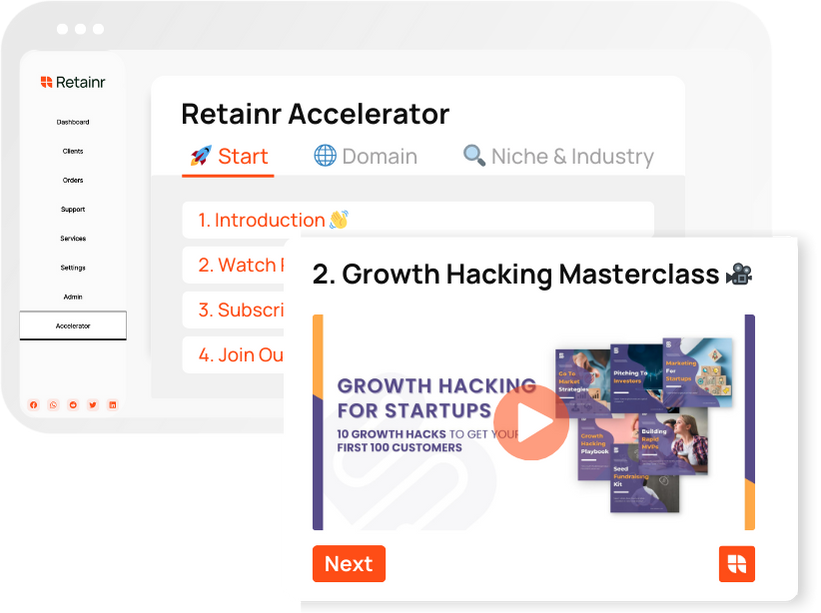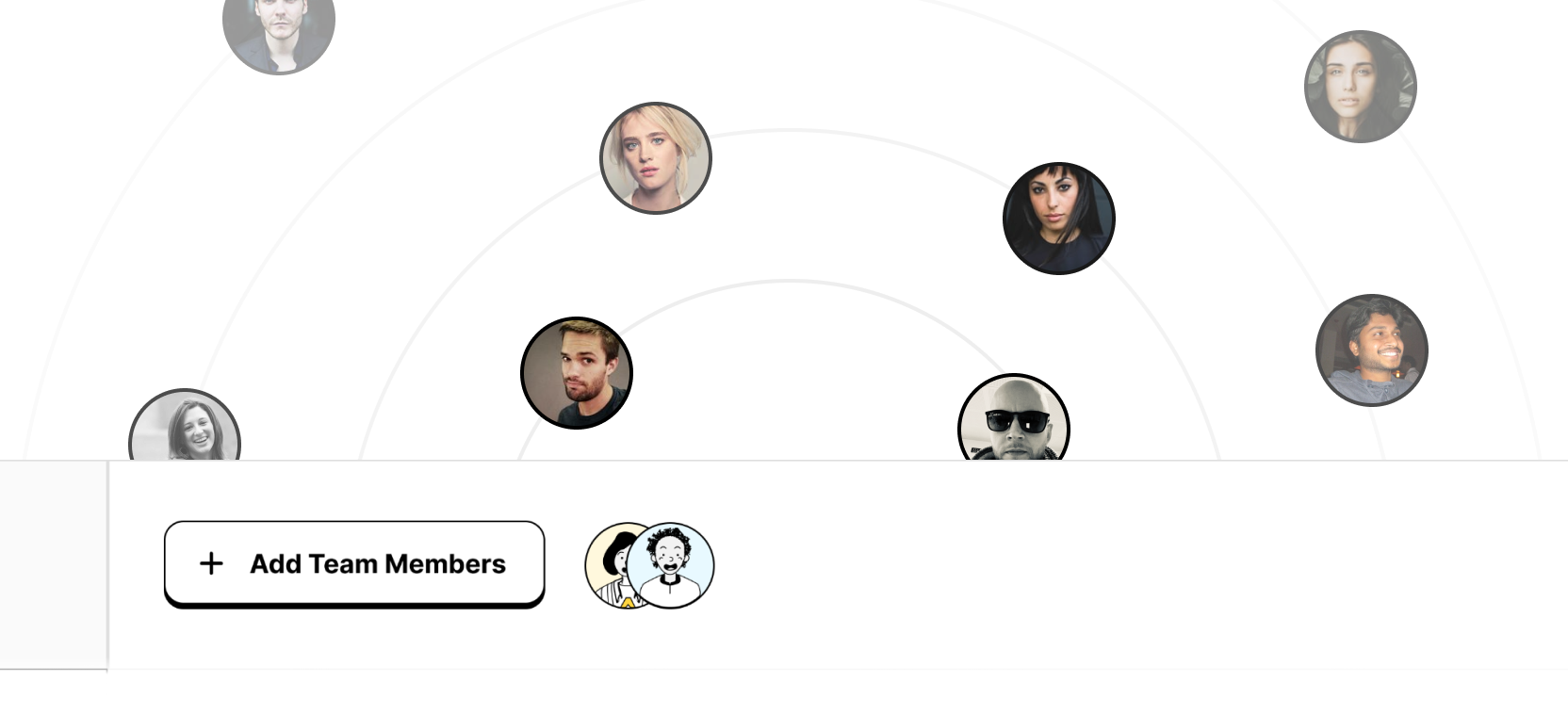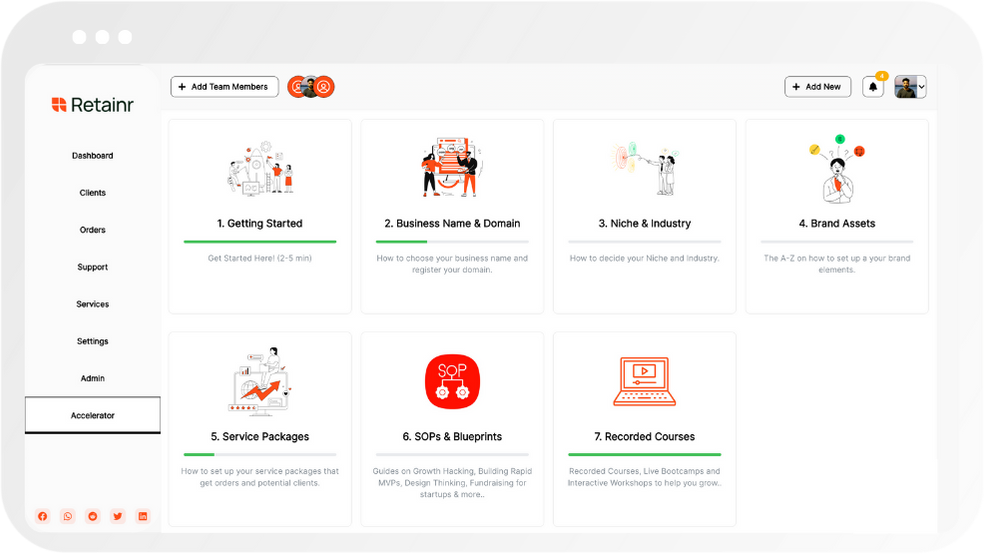
How to Conduct Productive Virtual Freelance Workshops: 8 Steps
Build with Retainr
Sell your products and services, manage clients, orders, payments, automate your client onboarding and management with your own branded web application.
Get Started1. What are some essential steps to follow when conducting productive virtual freelance workshops?
Planning and Preparation
Fundamentally, a successful virtual freelance workshop starts with careful planning and preparation. Take the following steps:
- Define the workshop's objectives: Knowing what you wish to achieve helps guide the content creation and aids participants in understanding the workshop's value.
- Identify your audience: Understanding your participants' skills, knowledge, and expectations will enable you to tailor the content appropriately.
- Develop engaging content: Engage your audience with interactive tasks, videos, and discussions to foster active learning.
- Select your tools: Make sure to choose virtual tools and platforms that facilitate interaction, and are user-friendly and reliable.
Workshop Execution
During the workshop, maintain control, engagement, and productivity with these steps:
- Start by setting the ground rules: This helps foster mutual respect and defines expectations for behaviour and engagement.
- Encourage interaction: Foster engagement by asking questions, encouraging participation, and acknowledging all contributions.
- Keep to time: Out of respect for participants and to ensure topics are covered, punctuality and time management are crucial.
- Feedback and Evaluation: Ask participants for their view on the workshop. This helps assess its effectiveness and identify areas for improvement.
Advantages and Disadvantages
| Advantages | Disadvantages |
|---|---|
| Wide Reach | Technical difficulties |
| Flexible scheduling | Time zone differences |
| Cost-effective | Potential lack of personal connection |
2. How do I plan an effective virtual workshop for freelance professionals?
Identify and Set Objectives
Establishing clear objectives is a crucial first step in planning an effective virtual workshop for freelance professionals. Start by distinguishing between your overall workshop aims, specific session objectives, and individual task goals:
- Workshop Aims: These are broad statements regarding the desired end result of the entire training. For instance, improving project management skills among independent consultants.
- Session Objectives: If your workshop will have multiple sessions, make sure to identify professional skills each session is designed to build or improve. For instance, one session may focus on task delegation, another on effective communication.
- Task Goals: Each task or exercise given during the workshop should have a clear purpose. These mini goals contribute to the overall learning objectives.
Select Appropriate Content and Tools
Once objectives are established, the next step is to select appropriate content and tools which align with your goals and objectives. Choose the tools that will stimulate active learning and foster engagement:
| Content Type | Tools |
|---|---|
| Interactive presentations | Prezi, Google Slides |
| Online quizzes and polls | Kahoot!, Slido |
| Collaborative projects | Miro, Google Docs |
Devise a Detailed Agenda and Schedule
A concise and well-thought-out schedule is paramount for a seamless running of any workshop. Never leave timings to chance. Ascertain that you factor in ample time for each session as well as a provision for breaks. Here is a possible way to structure your workshop:
- Introduction: Welcome and laying out workshop objectives (10 minutes)
- Overview presentation: Laying out key concepts (20 minutes)
- Activity 1: Interactive task or exercise (30 minutes)
- Break: A few minutes to recharge and take care of personal matters (15 minutes)
- Activity 2: Another exercise building on Activity 1 (30 minutes)
- Wrap-Up: Summary and Q&A (20 minutes)
3. Can you provide tips on ensuring engagement during virtual freelance workshops?
Tips for Ensuring Engagement During Virtual Freelance Workshops
When conducting virtual freelance workshops, maintaining participant engagement is crucial. Here are some tips to ensure engagement:
- Incorporate Interactive Elements: Use interactive tools like polls, quizzes, or live chat to engage participants. This not only provides a break from the lecture, but also enables people to contribute their ideas and questions.
- Varying Presentation Styles: Mix up your presentation styles to keep things fresh and exciting. This can be done by employing slides, videos, demonstrations, or participatory activities.
- Invite Guest Speakers: Inviting guest speakers can break the monotony and provide different perspectives on the topic.
Ensuring that the workshop is inclusive for everyone will also boost engagement. Here are a few strategies:
- Make Sure it is Accessible: Content should be easily accessible to everyone, regardless of any disabilities they may have. Include closed-captioning for videos or audio content, and ensure that your materials are screen-reader friendly.
- Provide Materials Ahead of Time: Giving participants the opportunity to preview materials before the workshop can help them participate more effectively.
- Create a Safe Environment: Foster an environment of respect and inclusivity. Encourage first-time speakers or those who are typically quiet to share their thoughts.
| Factor | Strategy |
|---|---|
| Interactive Elements | Use polls, quizzes, live chat. |
| Varied Presentation Styles | Use slides, videos, demonstrations. |
| Guest Speakers | Invite experts to offer different perspectives. |
| Accessibility | Include closed-captioning, screen-reader friendly material. |
| Preparatory Materials | Provide materials to participants in advance. |
| Safe Environment | Promote respect and encourage participation. |
4. What tools or platforms can I use to conduct productive virtual freelance workshops?
Virtual Workshop Tools and Platforms
There are various tools and platforms that can be used as resources to drive productivity in virtual freelance workshops. These resources encompass communication, project collaboration, and productivity tools that help in planning, execution, and managing tasks efficiently. Leveraging these platforms guarantees effective communication, smooth collaboration, and top-notch delivery of the workshops.
Below is a list of few recommended tools and platforms:
- Communication Tools: Skype, Zoom, Google Meet, Microsoft Teams for audio and video conferencing
- Collaboration Platforms: Google Workspace for documents sharing and real-time editing
- Project Management Tools: Trello, Asana, Monday for planning, tracking and managing projects
- Productivity Tools: Tools like Clockify and RescueTime for time tracking
Comparison of Virtual Workshop Platforms
With a variety of platforms available, choosing the right one can be a challenge. To aid in your decision, view the comparison table below which analyzes various features of popular platforms.
| Platform | Video Conferencing | Screen Sharing | Real-Time Editing | Task Management |
|---|---|---|---|---|
| Zoom | Yes | Yes | No | No |
| Google Workspace | Yes (Google Meet) | Yes (Google Meet) | Yes (Google Docs) | No |
| Microsoft Teams | Yes | Yes | Yes | Yes |
| Asana | No | No | No | Yes |
5. What are the key differences between conducting in-person and virtual workshops for freelancers?
Key Differences Between In-Person and Virtual Workshops
The pivot towards conducting workshops in a virtual mode has led freelancers to encounter numerous variations in their routine. These differences can significantly impact the execution, interaction, and visual experiences of the workshop.
Interaction and Participation
In a traditional workshop, one of the most significant differences is the interaction style. While in-person workshops often rely on verbal communication, body language, and real-time instant responses, virtual workshops usually depend on digital tools for interactivity. Reviews, polls, Q&A sections, chats, and emojis are typical elements of virtual interaction.
- In-person workshops allow for spontaneous brainstorming sessions, whiteboard demonstrations, and real life examples without digital interruptions.
- Virtual workshops require methods such as screen sharing, digital breakout rooms for group discussions, and online polls for interactive sessions.
Environmental and Technical Factors
A significant concern for virtual freelancers is the dependability on technology. Unlike in traditional settings where the setting is controlled, virtual workshops require participants to manage their internet connections, software, and devices. They also need to find comfortable, quiet spaces to promote focus and participation. The format must be well-thought-out, considering technical difficulties and differing time zones of international participants.
| In-Person Workshops | Virtual Workshops | |
|---|---|---|
| Dependability on Devices | Low | High |
| Environmental Control | High | Low |
| International Accessibility | Low | High |
6. How can I ensure that my virtual freelancing workshop remains interactive and productive?
Preparation for an Interactive Workshop
Ensuring interactivity in your virtual freelancing workshop first requires detailed planning and preparation. Start by outlining clear workshop goals, which will ultimately guide the progression and structure of your workshop. Timelines are equally important, create a workshop agenda that emphasizes regular participant interaction and feedback.
- Clear Workshop Goals: Set specific, measurable, achievable, relevant, and time-bound (SMART) goals.
- Workshop Agenda: Schedule specific times for discussions, questions, live polls, and breakouts.
- Pre-Workshop Material: Circulate reading material or videos before the workshop to give participants a head-start on the topic.
During the Workshop
During the workshop, employ a range of tools designed to heighten interactivity and engagement amongst participants. These tools are particularly effective in creating platforms for communication and collaboration in virtual learning environments.
| Interaction Tool | Description |
|---|---|
| Chat Functions | These tools allow participants to voice their thoughts and questions without interrupting the flow of the workshop. |
| Live Polls | Instant polls can provide real-time insights into participant understanding and engagement. |
| Breakout Rooms | These smaller groups encourage active participation and facilitate deeper discussions. |
Post-Workshop Follow Up
Engagement should not end when the workshop does. A post-workshop follow-up involving feedback collection and sharing of additional resources can help drive further engagement and learning. Keep lines of communication open to encourage a sustained relationship between the participants and the workshop facilitator.
- Feedback Collection: Use this to assess the workshop’s effectiveness and make improvements for future editions.
- Additional Resources: Sharing workshop slides, reading materials, and relevant links can help solidify the topics covered.
- Open Communication: Continue the conversation and facilitate a community of learning even after the workshop.
7. How can I effectively measure the productivity of my virtual freelance workshop?
Identifying Metrics
Measuring productivity involves defining the success parameters of your virtual freelance workshop. Hence, you should aim at identifying metrics that relate directly to your objectives. Key metrics that can be used to effectively measure productivity may include participation rates, completion rates, feedback scores, and assessments of participants' performance during and after the workshop. Importantly, remember to take note of technical issues faced by participants as well, as this could affect productivity.
- Participation Rates: Track the number of active participants.
- Completion Rates: Monitor how many participants complete the full workshop.
- Feedback Scores: Use surveys or polls to generate real-time feedback.
- Performance Assessments: Conduct quizzes or assign tasks to evaluate knowledge gain and skill acquisition.
- Technical Issues: Record the number of issues faced, and how quickly they were resolved.
Using Assessment Tools
There are various tools that can help you measure productivity in your virtual freelance workshop. Depending on the nature of your workshop, you could use online quizzes, project management apps, or digital survey platforms. Such tools can provide real-time reports and analytics about participants' engagement and performance during the workshop, allowing you to induce shifts in workshop content or delivery if necessary.
| Tool | Function |
|---|---|
| Online Quizzes | Conduct short quizzes after each key session to assess learning. |
| Project Management Apps | Keep track of project completion rates and individual contributions. |
| Digital Survey Platforms | Gather participants’ feedback and suggestions for improvement. |
Consolidating and Analyzing Data
Collecting data is only the first stage. It is equally important to consolidate and analyze the data in order to understand the productivity of your virtual freelance workshop. It is advisable to use data visualization tools for an easier interpretation of the data. By doing this, you can glean insights about what worked well, what can be improved, which topics were well received, and where participants faced difficulties. This will be invaluable for refining your workshop design and delivery in the future.
8. Are there any specific time-management strategies to consider while conducting virtual freelance workshops?
Time-Management Strategies for Virtual Freelance Workshops
Efficient time management plays a crucial role in conducting successful virtual freelance workshops. A well-structured agenda and outlined timeline can help to keep things on track and ensure productivity. Here are a few time-management strategies you should consider:
- Use the Pomodoro Technique: This method involves working for a specific set period (25 minutes is common), taking a short break, and then resuming work. After four cycles, take a longer break. This technique can improve focus and productivity.
- Set Clear Expectations: Ensure participants are aware of the workshop's overall timeline and set clear expectations for time allocation. This allows attendees to prepare and adjust their schedules accordingly.
- Deploy Break-Out Sessions: Divide lengthy seminars into smaller, digestible portions and then initiate group discussions to aid comprehension. These breaks also provide pause and refreshment, keeping engagement intact.
A Sample Workshop Time-Management Table
To put these strategies into practice, it can be helpful to visualise your timeline. This can be achieved through creating a table or schedule similar to the one below:
| Time | Activity | Description |
|---|---|---|
| 9:00-9:15 | Introduction | Outline the workshop's objectives and expectations |
| 9:15-9:45 | Presentation | Deliver the main content of the workshop |
| 9:45-10:00 | Break | Take a break prior to resuming with the Pomodoro Technique |
| 10:00-10:30 | Discussion/ Q&A | Conduct a Q&A session to clear up any points of confusion |
| 10:30-11:00 | Break-Out Sessions | Implement group discussions based on the workshop's topic |
Time management is paramount to ensuring efficiency and productivity in any workshop, especially when virtual. By employing these strategies, you can improve the effects of your virtual freelance workshops and ensure meaningful interaction.
9. What common challenges might arise during a virtual freelance workshop and how can they be mitigated?
Common Challenges during Virtual Freelance Workshops
Virtual freelance workshops offer a boundary-free platform for freelancers to connect, collaborate and learn. However, they also present unique challenges that can affect their flow and productivity. Amongst the most common challenges that might arise include:
- Technical Issues: This can include unstable internet connections, hardware problems, or software glitches.
- Time zone Differences: Since freelancers are often spread across different time zones, scheduling meetings can be tricky.
- Miscommunications: These might occur due to language barriers, poor audio quality, or lack of non-verbal cues common in face-to-face meetings.
- Distractions: Home environments may often be filled with potential distractions which can make focusing difficult.
- Lack of participation: The distance and possible anonymity can lead to a lack of engagement and contribution from attendees.
How to Mitigate these Challenges
Navigating these challenges requires tactful planning, communication, and utilization of technology. Below are strategies to tackle each challenge:
| Challenge | Solution |
|---|---|
| Technical Issues | Encourage participants to check their equipment beforehand and offer basic tech support or guides. |
| Time zone Differences | Use scheduling tools that adjust to each participant's time zone. |
| Miscommunications | Ensure clear audio and video, use chat functions for clarity, and encourage an atmosphere of patience and understanding. |
| Distractions | Encourage participants to find a quiet place, use headphones, and mute their microphones when not speaking. |
| Lack of participation | Engage participants with interactive sessions, make use of breakout rooms for small group discussions, ask for contributions directly. |
Note that the effectiveness of these methods depends largely on the nature and scope of your workshop, as well as the individual needs and characteristics of your attendees.
10. How can I tailor my virtual freelance workshop content to fit the specific needs of my audience?
Know Your Audience
Understanding your audience is the first and foremost step in tailoring any content. Do a detailed research on your target audience. For example, identify their professional background, their level of expertise in the subject of your workshop, and their learning styles. This will give you an idea of how to structure your content and the approach you should take.
- Professional background: Are they beginners or experienced freelancers? Are they from a technical background or creative field?
- Level of expertise: Do they need basic information or are they looking for advanced tips and strategies?
- Learning styles: Do they prefer visual content like slides and infographics, or are they more into audio and video content?
Plan and Structure Your Content
Allot time to plan and structure your content based on the research about your audience. It's always better to have a clear plan before you start creating the content for your virtual freelance workshop.
| Steps | Description |
|---|---|
| Outline your content | Define the major sections of your workshop and what each section will cover. This will serve as a blueprint for your workshop. |
| Choose the right format | If your audience prefers visual content, use more slides and infographics. If they prefer audio, incorporate more discussions and Q&A sessions. |
| Balance theory and practice | The best way to ensure the content sticks is by including practical activities and exercises. |
Tailor your Content
Now that you have a clear idea of your audience and you have planned your content, it's time to tailor your content. Always make sure that your content resonates with the audience. Try to include examples and case studies that the audience can relate to. You can even adjust the language and tone of your content based on the level of expertise of your audience.
- Connect the topic with the audience's interests or professional field.
- Adjust the complexity level of the content based on the audience's level of expertise.
- Use real world examples and case studies that the audience can relate to.
Conclusion
Master the Virtual Freelance Workshop with 8 Productive Steps
Conducting a fruitful virtual freelance workshop is an art that requires adequate planning, embracing technology, encouraging group work among attendees, creating a comfortable virtual environment, well-prepared presentations, penning down the follow-up actions, and ensuring consistent learning and growth.
1. Understand your Audience's Needs
Carrying out a preliminary survey to delve into the specific needs and expectations of your audience can be very fruitful. Craft your workshop accordingly to make it useful and engaging for your attendees.
2. Leverage the Competitive Edge of Technology
Next, it’s essential to leverage technology, such as Retainr.io, a white-label software solution for freelancer businesses. It helps you manage clients, orders, payments, and more. You can brand your workshop under your own business name, enhancing its professionalism. Check it out here.
3. Empower Attendees to Work in Groups
Encouraging attendees to interact in groups can be a great way to promote learning and creativity. It’s an effective method to stimulate your workshop and increase attendee satisfaction.
4. Create a Comfortable Learning Environment
Managing attendees' expectations right from the start and creating an atmosphere of ease can facilitate more open communication, making it an enriching experience for everyone.
5. Craft and Deliver Persuasive Presentations
A well-planned presentation that engages attendees and communicates your message powerfully can make your workshop a grand success.
6. Keep Track of Attendee Progress
Crafting a robust follow-up plan, setting up systematic reminders, tracking and reviewing attendees' progress is essential for their long-term learning and growth.
7. Encourage Continuous Learning
Encourage your attendees to continue learning beyond the workshop. Sharing relevant resources and tools can foster further interest in your subject matter.
8. Always Be Open to Feedback
Post-workshop feedback from your attendees is gold dust. It can provide insights into areas of improvement and help you deliver even better workshops in the future.
To summarise, conducting productive virtual freelance workshops require planning, technological adoption, and a great deal of interactivity. And, when technology is mentioned, there’s no better way than using Retainr.io. This all-in-one software will take care of managing your clients, orders, and payments, making your workshop experience smooth and hassle-free.
Boost Your Agency Growth
with Retainr Accelerator
Uncover secrets, strategies, and exclusive blueprints to take your agency's growth to the next level — from marketing insights to effective presentations and leveraging technology.

SOPs, Cheatsheets & Blueprints
Leverage 50+ SOPs (valued over $10K) offering practical guides, scripts, tools, hacks, templates, and cheat sheets to fast-track your startup's growth.
Connect with fellow entrepreneurs, share experiences, and get expert insights within our exclusive Facebook community.
.jpg)

Join a thriving community of growth hackers. Network, collaborate, and learn from like-minded entrepreneurs on a lifelong journey to success.

Gain expertise with recorded Courses, Live Bootcamps and interactive Workshops on topics like growth hacking, copywriting, no-code funnel building, performance marketing and more, taught by seasoned coaches & industry experts.

.jpg)

.jpeg)


